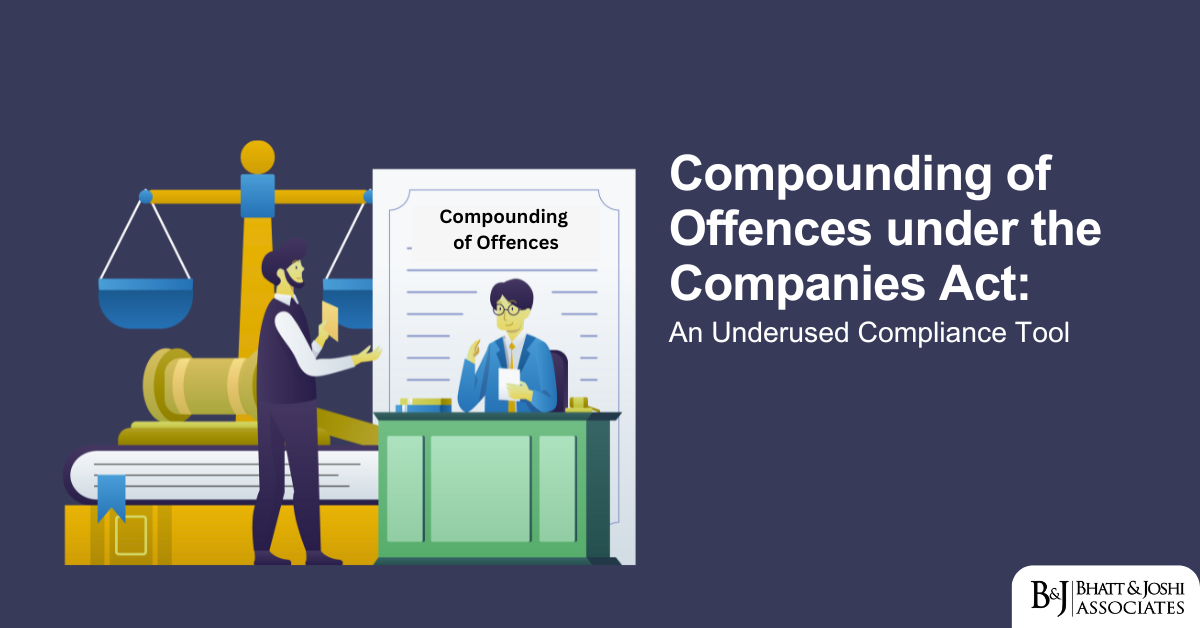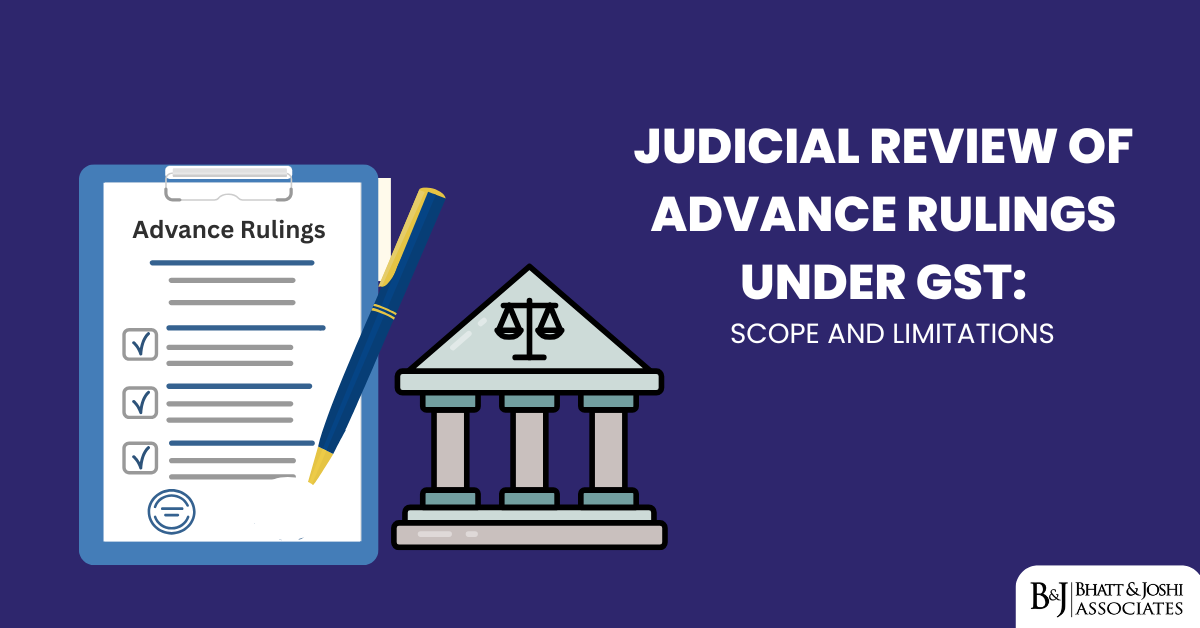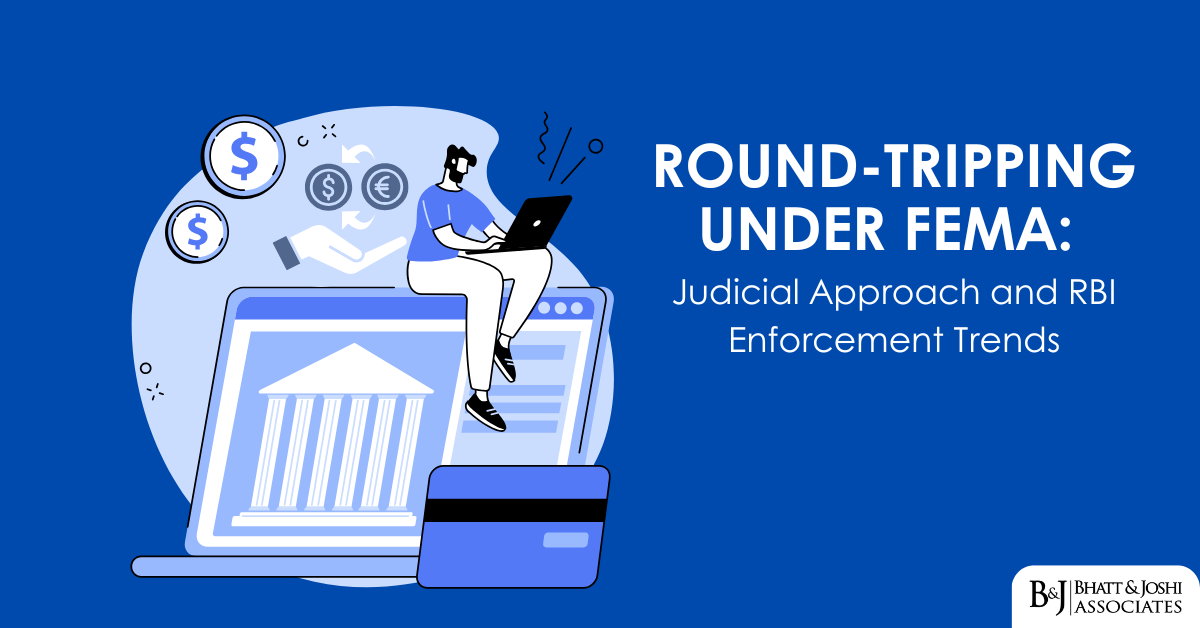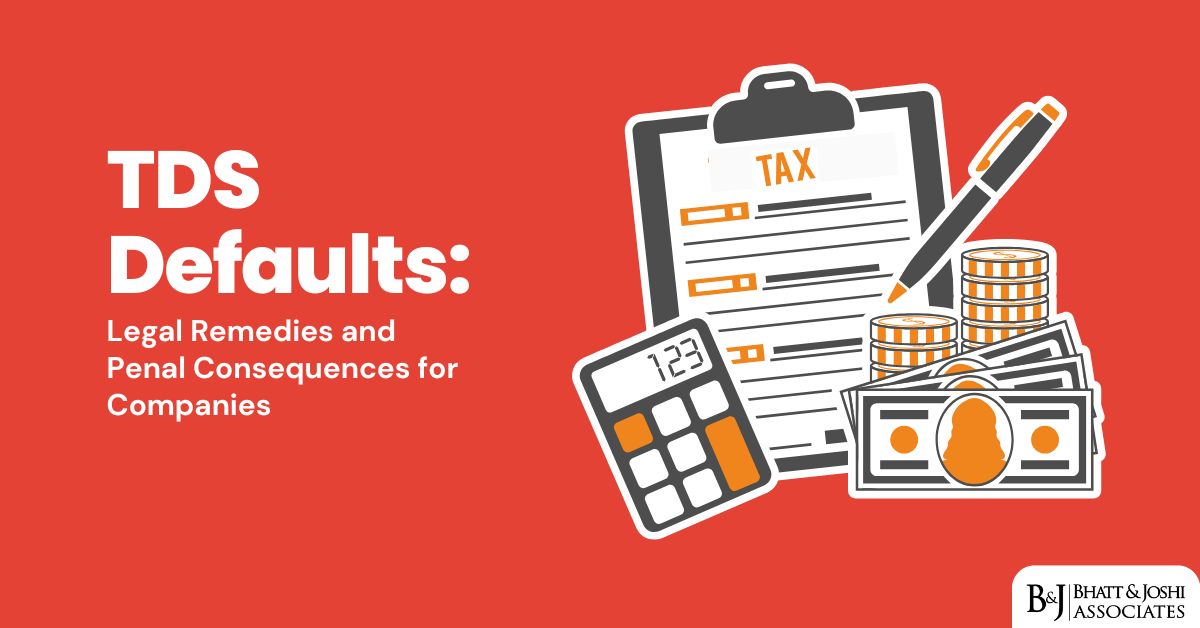Introduction
The Companies Act, 2013, which replaced its 1956 predecessor, introduced a more robust framework for corporate governance while simultaneously enhancing the enforcement mechanism for statutory compliance. Within this enforcement framework, the compounding of offences stands as a significant yet underutilized compliance tool that offers a middle path between strict prosecution and complete absolution. Compounding essentially allows companies and their officers to admit to technical or minor violations, pay a specified monetary penalty, and avoid the protracted process of criminal litigation. This mechanism serves the dual purpose of ensuring regulatory compliance while preventing the overburdening of the judicial system with matters that can be effectively resolved through administrative channels. Despite these apparent advantages, the compounding provision remains surprisingly underutilized in the Indian corporate landscape. This article examines the statutory framework, procedural aspects, advantages, limitations, and potential reforms related to the compounding of offences under the Companies Act, 2013, with particular emphasis on its status as an underused compliance tool that merits greater attention from both corporate management and legal practitioners.
Statutory Framework and Evolution of Compounding of Offences under the Companies Act
The concept of compounding corporate offences predates the Companies Act, 2013, finding its origins in the Companies Act, 1956. Under Section 621A of the 1956 Act, certain offences were compoundable, primarily those punishable with fine only. The 2013 Act significantly expanded and refined this mechanism, reflecting a more nuanced approach to corporate violations that distinguishes between serious offences requiring criminal prosecution and technical breaches that can be more efficiently addressed through administrative remedies.
Section 441 of the Companies Act, 2013, constitutes the primary statutory provision governing the compounding of offences under the companies Act. This section explicitly authorizes the Regional Director or the National Company Law Tribunal (NCLT) to compound offences punishable with imprisonment, fine, or both. The jurisdiction is determined by the maximum amount of fine prescribed for the offence – the Regional Director can compound offences with a maximum fine up to five lakh rupees, while the NCLT handles offences with higher potential penalties.
Critically, Section 441(6) explicitly excludes certain categories of offences from the compounding framework. These include offences where investigation has been initiated or is pending against the company, offences committed within three years of a previous compounding of similar offences, and offences involving transactions that affect the public interest directly. This careful delineation ensures that the compounding mechanism remains reserved for appropriate cases rather than becoming a tool for serial offenders or those committing serious violations.
The Companies (Amendment) Act, 2019, introduced significant reforms to the compounding framework, reflecting legislative recognition of both its importance and the need for refinement. These amendments included clarification of the Regional Director’s power to compound offences with maximum penalties up to 25 lakh rupees and simplification of the procedure for certain technical violations. The amendment also introduced Section 454A, which prescribes higher penalties for repeat offences, creating a deterrent against viewing compounding as merely a “cost of doing business.”
The Companies (Amendment) Act, 2020, continued this evolutionary trajectory by decriminalizing certain minor, technical, and procedural defaults through reclassification from criminal offences to civil penalties under the in-house adjudication mechanism. This reform reinforced the legislative intent to distinguish between serious offences requiring criminal prosecution and technical non-compliances that can be addressed through administrative channels such as compounding.
This statutory evolution reflects a progressive recognition that not all corporate offences warrant the full machinery of criminal prosecution. Rather, a calibrated approach—such as the Compounding of Offences under the Companies Act—serves both regulatory and efficiency objectives, allowing for effective enforcement without overburdening the judicial system.
Procedural Framework and Practical Aspects
The compounding procedure under the Companies Act follows a structured path that balances procedural efficiency with necessary safeguards. Understanding this procedural framework is essential for companies seeking to utilize this compliance tool effectively.
The process of Compounding of Offences under the Companies Act typically begins with the preparation and submission of a compounding application in Form GNL-1 through the MCA-21 portal. This application must include a detailed disclosure of the violation, the relevant statutory provision, the period of default, the circumstances leading to the non-compliance, and whether any similar offence has been compounded within the preceding three years. The application must be accompanied by the prescribed fee and a condonation of delay application if the filing is beyond the stipulated timeframe.
Upon receipt, the Regional Director or NCLT, as applicable, examines the application and may request additional information or clarification if necessary. The authority then determines the sum payable for compounding, considering factors such as the nature of the offence, the default period, the size of the company, the compliance history, and any unjust enrichment or loss caused by the violation. This discretionary assessment allows for a contextualized approach that considers the specific circumstances of each case.
After payment of the compounding fee, the Regional Director or NCLT issues a compounding order, which effectively disposes of the proceedings related to the offence. Section 441(4) explicitly states that any offence properly compounded shall not be subject to further prosecution, and any pending proceedings related to that offence shall be deemed to be withdrawn.
Importantly, Section 441(5) requires disclosure of all compounding orders in the subsequent Board’s Report to shareholders, ensuring transparency and accountability to the company’s stakeholders. This disclosure requirement serves both informational and deterrent purposes, as companies typically prefer to avoid repeated disclosures of regulatory non-compliance.
From a practical perspective, several challenges exist in the compounding process that may contribute to its underutilization. These include uncertainty regarding the calculation of compounding fees, which involves considerable discretion; delays in processing applications, which can sometimes extend to several months; the requirement for personal appearances by directors or officers, which can be particularly burdensome for foreign directors; and the disclosure requirement, which creates reputational concerns for listed companies in particular.
Despite these challenges, the procedural framework for compounding remains significantly more streamlined than the alternative of criminal prosecution. Companies that effectively navigate this process can typically resolve non-compliances within a matter of months rather than years, with far less managerial distraction and legal expense than full-fledged litigation.
Advantages of the Compounding Mechanism under the Companies Act
The compounding mechanism offers several distinct advantages that merit greater attention from the corporate community. These advantages span legal, financial, operational, and reputational dimensions, collectively making compounding an attractive option for addressing many types of corporate non-compliance.
Perhaps the most significant advantage is the avoidance of criminal prosecution and its attendant consequences. Criminal proceedings entail not only potential imprisonment for officers but also prolonged litigation, multiple court appearances, and the stress associated with criminal charges. For foreign directors or executives, criminal proceedings can create particular complications regarding travel to India and immigration status. The compounding of offences under the companies act effectively neutralizes these risks, providing a definitive resolution that precludes further criminal action for the offence.
Expeditious resolution represents another major advantage. While the Indian judicial system is renowned for its lengthy proceedings, compounding typically concludes within three to six months from application submission. This efficiency allows companies to resolve compliance issues promptly rather than having them hang like a sword of Damocles for years. The time saved translates directly to reduced legal costs, lower management distraction, and faster restoration of normal corporate operations.
Financial predictability constitutes a third significant advantage. Unlike court-imposed penalties, which can be unpredictable and may include both fines and imprisonment, compounding fees typically follow relatively established patterns based on the nature of the violation, the default period, and other relevant factors. This predictability enables companies to make informed cost-benefit analyses when deciding whether to pursue compounding for particular violations.
From a regulatory relationship perspective, voluntary disclosure through compounding demonstrates good corporate citizenship and a commitment to compliance. Regulators often view companies that proactively address violations through compounding more favorably than those that adopt adversarial stances or attempt to conceal non-compliance. This goodwill can prove valuable in future regulatory interactions, potentially resulting in more favorable treatment on discretionary matters.
For listed companies, compounding offers the advantage of definitive resolution with relatively minimal market impact. When a listed company faces prolonged criminal proceedings, market speculation and negative sentiment can significantly impact share prices. Compounding allows for a single disclosure of both the violation and its resolution, typically generating less negative market reaction than ongoing criminal litigation.
From a governance perspective, compounding creates an opportunity for companies to strengthen their compliance frameworks. The process of identifying, disclosing, and addressing violations often highlights systemic weaknesses in compliance processes. Forward-thinking companies use the compounding experience not merely as a means of resolving past non-compliance but as a catalyst for improving future compliance through enhanced systems, training, and monitoring.
These multifaceted advantages make compounding an attractive option for addressing many types of corporate non-compliance. The relatively swift, predictable, and final resolution it offers stands in stark contrast to the uncertainty, expense, and protracted nature of criminal proceedings. For companies focused on sustainable compliance rather than merely avoiding punishment, compounding represents a constructive pathway to resolving past issues while strengthening future practices.
Limitations of Compounding of Offences under the Companies Act
Despite its advantages, the compounding mechanism faces several limitations and challenges that contribute to its underutilization. These constraints operate at statutory, procedural, and perceptual levels, collectively impeding fuller adoption of this compliance tool.
The statutory restriction on repeat compounding represents a significant limitation within the framework of compounding of offences under the companies act. Section 441(6) prohibits compounding offences that have been previously compounded within the past three years. While this restriction serves a legitimate purpose in preventing serial offenders from using compounding as a mere cost of doing business, it creates a challenging situation for companies with multiple legacy compliance issues. Such companies must carefully sequence their compounding applications to avoid rendering some offences non-compoundable, a strategic complexity that discourages utilization.
Jurisdictional ambiguity presents another challenge, particularly for offences with penalties involving both imprisonment and fines. While Section 441 assigns compounding authority between the Regional Director and NCLT based on the maximum fine amount, the situation becomes less clear when imprisonment is also prescribed. Different jurisdictions have sometimes interpreted these provisions inconsistently, creating uncertainty for companies contemplating compounding applications.
The requirement for personal appearance by directors or officers during compounding proceedings creates a significant practical hurdle, particularly for foreign directors or companies with geographically dispersed leadership. While intended to ensure accountability, this requirement imposes substantial burdens in terms of travel, time, and logistics. During the COVID-19 pandemic, some relaxations were introduced allowing virtual appearances, but these have not been consistently implemented across all jurisdictions.
Disclosure requirements create reputational concerns that deter some companies from pursuing compounding. Section 441(5) mandates disclosure of all compounding orders in the subsequent Board’s Report, while listed companies must also make market disclosures. For companies with strong compliance reputations or those operating in sensitive sectors, these disclosure requirements can create reluctance to acknowledge violations publicly, even when compounding would otherwise be advantageous.
Inconsistency in calculating compounding fees represents a significant procedural challenge. While the statute provides general principles for determining fees, considerable discretion remains with the compounding authorities. This discretion has led to variations in fee calculation across different regions and over time, creating uncertainty for companies attempting to forecast the financial implications of compounding applications.
The absence of clear timelines for processing compounding applications creates another procedural hurdle. While compounding is generally faster than criminal prosecution, the actual processing time can vary significantly based on the authority’s workload, the complexity of the case, and other factors. This temporal uncertainty complicates corporate planning and can reduce the attractiveness of the compounding option.
The interaction between compounding and other enforcement mechanisms also creates complexity. For example, the relationship between compounding under Section 441 and the in-house adjudication mechanism under Section 454 is not always clear, particularly after the decriminalization amendments. This regulatory overlap can create confusion regarding the appropriate compliance pathway for specific violations.
Finally, a cultural preference for litigation over settlement within some corporate legal departments represents a perceptual barrier to compounding. Legal advisors accustomed to contesting allegations may reflexively recommend defending against charges rather than acknowledging violations through compounding, even when the latter would be more cost-effective and efficient.
These limitations and challenges collectively contribute to the underutilization of the compounding mechanism. Addressing these constraints through legislative reform, procedural streamlining, and cultural shift could significantly enhance the utility of this valuable compliance tool.
Comparative Perspectives on Compounding Mechanisms
Examining compounding mechanisms in other jurisdictions provides valuable contextual understanding and potential models for enhancing India’s approach. While terminology and specific procedures vary, many developed legal systems have established alternatives to criminal prosecution for corporate regulatory violations.
In the United Kingdom, the concept of “regulatory enforcement undertakings” under the Regulatory Enforcement and Sanctions Act, 2008, serves a similar function to India’s compounding mechanism. This framework allows companies to voluntarily commit to actions remedying non-compliance and its effects, often including compensation to affected parties and future compliance measures. Unlike India’s primarily monetary approach, the UK system emphasizes remediation and forward-looking compliance. Financial Conduct Authority (FCA) settlements similarly provide mechanisms for resolving regulatory violations without full prosecution, though with greater emphasis on meaningful corporate reforms beyond monetary penalties.
The United States offers multiple parallel mechanisms, including the Securities and Exchange Commission’s “neither admit nor deny” settlements, Deferred Prosecution Agreements (DPAs), and Non-Prosecution Agreements (NPAs). These mechanisms allow companies to resolve regulatory violations without formal admission of guilt, though typically with substantial monetary penalties and compliance undertakings. The U.S. approach generally involves more negotiation and tailored compliance obligations than India’s more standardized compounding framework.
Singapore’s regulatory composition framework under various financial and corporate statutes closely resembles India’s compounding mechanism but with greater procedural clarity and efficiency. The Monetary Authority of Singapore and the Accounting and Corporate Regulatory Authority have established transparent guidelines for composition amounts and processing timelines, creating greater certainty for regulated entities. This clarity has contributed to higher utilization rates of composition as a compliance resolution tool in Singapore.
Australia’s enforceable undertakings system administered by the Australian Securities and Investments Commission provides another instructive model. This system emphasizes both accountability for past violations and concrete reforms to prevent recurrence. Companies entering enforceable undertakings typically commit to specific compliance improvements, independent monitoring, and remediation of harm caused by violations, creating a more holistic approach to regulatory resolution than India’s primarily financial compounding mechanism.
Several insights emerge from these comparative perspectives. First, successful compounding or settlement frameworks typically provide greater procedural clarity and predictability than India’s current system. Second, many jurisdictions have moved beyond purely monetary penalties to include remedial and forward-looking compliance measures as part of regulatory settlements. Third, systems that provide transparent guidelines for calculating settlement amounts generally achieve higher utilization rates than those with more opaque determination processes.
These international models suggest potential enhancements to India’s compounding framework that could increase its utilization while strengthening its regulatory effectiveness. Incorporating elements such as clearer guidelines for compounding fees, streamlined procedures with defined timelines, and integration of compliance improvement commitments could transform compounding from an underused option into a cornerstone of India’s corporate compliance landscape.
Recommendations for Reform of Compounding under the Companies Act
Based on the analysis of the current framework’s limitations and international best practices, several targeted reforms could enhance the effectiveness and utilization of the compounding mechanism under the Companies Act, 2013:
Legislative clarification of compounding jurisdiction would address current ambiguities, particularly for offences involving both imprisonment and financial penalties. Amendment of Section 441 to provide explicit jurisdictional guidelines for various offence categories would reduce uncertainty and procedural delays. This clarification could include a comprehensive schedule categorizing all compoundable offences with clear assignment of jurisdiction between the Regional Director and NCLT.
Introduction of clear guidelines for calculating compounding fees would enhance predictability and consistency. While maintaining appropriate discretion for case-specific factors, the Ministry of Corporate Affairs could establish baseline calculation methodologies for different categories of offences, default periods, and company sizes. These guidelines would enable companies to forecast compounding costs more accurately, facilitating informed compliance decisions.
Streamlining the procedural framework through technology could significantly enhance efficiency. Expansion of the MCA-21 portal to include a dedicated compounding module with automated tracking, standardized documentation requirements, and integrated payment processing would reduce administrative burdens for both applicants and authorities. Implementation of maximum processing timelines with built-in escalation mechanisms for delayed applications would address the current temporal uncertainty.
Relaxation of personal appearance requirements, particularly for technical violations, would remove a significant practical barrier to compounding. Permanently adopting the virtual appearance options temporarily implemented during the COVID-19 pandemic would facilitate participation by geographically dispersed directors while maintaining accountability. For purely technical violations without elements of fraud or investor harm, consideration could be given to eliminating the personal appearance requirement entirely.
Modification of the repeat compounding restriction in Section 441(6) would enable more companies to utilize this mechanism effectively. Rather than a blanket three-year prohibition on compounding similar offences, a more nuanced approach could apply escalating penalties for repeat violations while still allowing compounding. This modification would particularly benefit companies working to resolve legacy compliance issues through systematic compounding.
Integration of compliance improvement mechanisms into the compounding framework would enhance its regulatory value. Drawing from international models, the compounding order could include commitments to specific compliance improvements related to the violation. These forward-looking elements would transform compounding from a purely remedial measure into a tool for sustainable compliance enhancement.
Creation of a specialized compounding bench within the NCLT would develop expertise and consistency in handling compounding applications. This specialized bench could establish precedents for similar cases, develop standardized approaches to common violations, and process applications more efficiently than generalist tribunals handling diverse corporate matters.
Development of comprehensive compliance guidance alongside the compounding framework would help companies avoid violations requiring compounding. The Ministry of Corporate Affairs could issue detailed compliance manuals, conduct regular awareness programs, and provide advisory services for complex compliance areas, reducing the need for compounding through improved preventive compliance.
These targeted reforms would address the key limitations in the current compounding framework while preserving its fundamental character as an efficient alternative to criminal prosecution. By enhancing predictability, streamlining procedures, removing unnecessary barriers, and incorporating forward-looking compliance elements, these reforms could transform compounding from an underutilized option into a cornerstone of corporate compliance in India.
Conclusion
The compounding of offences under the companies Act represents a valuable compliance tool that balances regulatory enforcement with procedural efficiency. It offers companies a pragmatic middle path between protracted criminal litigation and regulatory absolution, enabling resolution of technical violations while avoiding the significant burdens of prosecution. Despite these apparent advantages, the mechanism remains surprisingly underutilized in India’s corporate landscape.
This underutilization stems from multiple factors, including statutory limitations, procedural ambiguities, practical challenges, and perceptual barriers. The restriction on repeat compounding, jurisdictional uncertainties, personal appearance requirements, disclosure concerns, and inconsistent fee calculation collectively create impediments to wider adoption. These limitations are not insurmountable, however, and targeted reforms could significantly enhance the mechanism’s accessibility and effectiveness.
The comparative analysis reveals that many developed jurisdictions have successfully implemented similar alternatives to prosecution, often with greater procedural clarity and broader remedial focus than India’s current framework. These international models offer valuable insights for potential reforms, particularly regarding predictability, efficiency, and integration of compliance improvement elements.
The recommended reforms—including legislative clarifications, standardized fee guidelines, procedural streamlining, appearance flexibility, modification of repeat restrictions, compliance integration, specialized tribunals, and enhanced guidance—collectively address the key limitations of the current framework. Implementing these reforms would transform compounding from an underused option into a cornerstone of India’s corporate compliance landscape.
Beyond technical amendments, a broader shift in corporate compliance culture is necessary for compounding to reach its full potential. Companies must recognize compounding not merely as a mechanism for avoiding prosecution but as an opportunity for systematic compliance improvement. Similarly, regulators should view compounding not simply as a punitive tool but as a constructive pathway for bringing companies into sustainable compliance.
As India continues to refine its corporate governance framework, the compounding mechanism deserves greater attention from policymakers, regulators, corporate management, and legal practitioners. A well-functioning com














